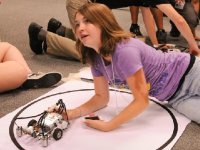6 Strategies to Truly Personalize PBL
PBL best embodies personalized learning when you know the whole child, align projects with standards, build a supportive infrastructure, assess often, and get out of the way.
In the past, I wrote about how, along with other teachers, I've ventured into truly personalized project-based learning. I discussed the challenges we face as well as what it looks like in the classroom. Many of us may be personalizing PBL without even knowing it.
Teachers have always had students pursue their own research projects on their own questions. Students around the globe are engaged in genius hour activities about their passions and are given voice and choice in how they show their learning. These are just some aspects of personalized PBL, and we can improve the model further still when we adopt more tenets of personalization into the already-existing PBL framework. In addition, many teachers are claiming that they're personalizing learning for students when in fact they are not. However, PBL and personalized learning make an excellent match that creates engagement for students through authentic, personal work on content and skills that they want and need. Here are six strategies that you can try.
1. Know the Whole Child
If you don't know your students, it will be impossible to personalize learning for them. Assessment (not grades) is key here. Pre-assessments and ongoing formative assessments can provide excellent information on how students are doing, what they need, and what we can do as educators to empower them in the learning process. Schools can use ASCD's School Improvement Tool to assess for the whole child and set goals for improvement.
2. Scaffold Questioning
Our students are naturally curious, but they may need further support to articulate those questions and ask even deeper and more targeted questions. As students start to identify their interests and passions, we should be giving them tools like question stems, models of asking great questions, examples of leveled questions, graphic organizers, and the like to help them ask about what they want and need to know. Protocols like the Question Formulation Technique or the 5 Whys can also be great tools for scaffolding questions. If we want students to learn, we should encourage all types of questioning that lead to deeper learning. The best part is that, through this scaffolding, students ultimately own the questions and can personalize their project from the answers. Students are the true creators of PBL driving questions. In this Teaching Channel video, a teacher helps students learned leveled questioning.
3. Know and Align the Standards or Outcomes
There may come a time when learning will be so open that students will be able to learn whatever they want. However, in this day and age, we are accountable to learning standards and outcomes. This doesn't mean that we can’t be flexible in how we help students reach these learning objectives. And personalized PBL can help us find that flexibility. As students generate their questions, project ideas, and products for learning, teachers must align their work to standards and outcomes, which means that teachers need to know their standards deeply in order to serve as translators of students' personalized projects to the standards. Teachers can create checklists of the standards, sub-standards, and outcomes to work through the "weeds" of hitting the standards through personalized projects, and they can use these checklists with students to co-create project ideas and assessments. See Edutopia's Building Rigorous Projects That Are Core to Learning for ideas.
4. Build the Infrastructure
Although there is more openness and flexibility in personalized PBL, we do need some processes, protocols, and procedures to make sure that students can self-manage and complete projects with reasonable timelines. Student planning forms such as calendars, task lists, and the like can help students create deadlines and benchmarks for peer feedback, teacher feedback, and reflections. Technology tools can also support an infrastructure in which students have control over the scope of the project. The Teaching Channel offers a video about group contracts for collaborative work.
5. Assess Often
Ongoing assessment is an additional part of a good infrastructure for personalized PBL. Teachers and students should assess the work often to align the resources and instruction needed for success. These ongoing formative assessments can allow students to set goals while allowing teachers to give students "just in time" instruction in a variety of ways. These assessments should not be graded, allowing students the opportunity and safety to improve toward a summative final product. Teachers in this Edutopia video on multifaceted assessment explain how they assess along the way.
6. Get Out of the Way
One major challenge for any PBL teacher, and especially with personalized PBL, is getting out of the way. Although a teacher needs to be present, he or she also needs to relinquish control to the students, allowing them to explore their passions in learning. However, through letting go, teachers can move strategically from student to student as they all engage in different personalized PBL projects. Aviation High School's Scott McComb not only lets his students pick their teams, he also has them set norms, make mistakes, and adjust goals accordingly.
I truly believe that we can make personalized PBL happen and would love to hear your stories about how it has worked with your students or how you plan to try it out. Since we all know that students are engaged when they receive the learning and instruction that they want and need, why shouldn't personalized PBL be that learning model?
